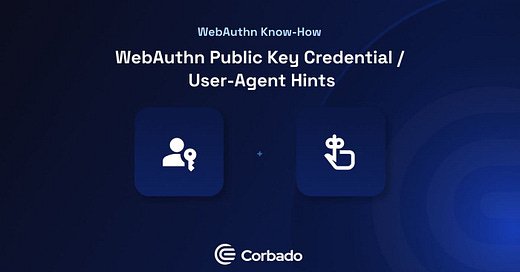Passkey Implementation Challenges, WebAuthn Hints & Passkeys Stakeholder Engagement - This Week at Passkeys
Passkey Implementation Challenges - WebAuthn Hints - Passkeys Stakeholder Engagement
What a Week!
👆 WebAuthn Public Key Credential / User-Agent Hints
🧔 Stakeholder Engagement (Enterprise Passkeys Guide 2)
Here are this week’s topics that you don’t wanna miss out on!
Different passkey implementation challenges of developers & enterprises
“I want to add passkeys”
Short sentence, vast difference in meaning.
We hear this statement quite often & it can mean wildly different things depending on who we talk to. Usually, there are 2 groups:
1) Developers working on smaller projects:
they need to ship fast
solve the tech complexities of web standards quickly
want to avoid drowning in things like session management, data encoding or building user flows
2) Enterprise teams responsible for:
massive user bases
multi-app environments
compliance audits
brand consistency across multiple platforms.
This reflects also in the passkey challenges that they’re facing:
🧑💻 Devs:
Unknown WebAuthn specs:
WebAuthn is for most devs a new standard & just keeping up can feel like a second job and many don’t know where to start (also due to the lack of good references).Quick PoC vs. live app:
Some devs piece together open-source libs & get passkey creation + login quickly to work, only to discover that’s just 5%. Handling cross-platform complexities or fallback logic often demands a more elaborated approach.Unknown unknowns:
Passkey-readiness detection, encoding / decoding new data formats (enjoy CBOR), bridging front-end and back-end flows, detecting passkey-readiness and availability, avoiding user confusion - looks easy on first sight but new challenges will pop up all the time.
🏢 Large-scale organizations:
Biggest fear: passkeys break the login & users are locked out:
Passkeys need to be integrated into existing auth infrastructure. Replacing systems & migrating user data is a nightmare for every CISO / CTO. Huge project. Risky. Lengthy. Costly. So most enterprise leaders prefer a riskless, gradual rollout that won’t break existing logins.User onboarding & fallback flows:
Millions of users, each with different devices, operating systems, browsers & skill levels, need to be taken care of. Ensuring a smooth passkey experience means reliable fallback methods and clear UX - even on non-passkey-ready devices.Performance, security & ROI:
Large-scale deployments need advanced analytics to track login success rates, measure ROI against SMS or IT helpdesk costs and prove compliance to internal security teams & external regulators. All things that stack up when working on large-scale passkey projects.
Many encounter these challenges when already implementing passkeys as the assumption was that quickly setting up a WebAuthn server should be fine. However:
You can’t just implement a bare-bones WebAuthn server & expect a successful passkey project. To build a product that users really like to use , much more is needed.
In other words, passkey implementation ≠ passkey adoption.
Successful passkey adoption, especially in consumer apps, requires a holistic approach integrating product, engineering, customer support, security & compliance - treating adoption as important as implementation from day 1.
Question from passkey integration projects
In this post, we’re introducing a new category. Over the past few months, we've been repeatedly asked about best practices for integrating passkeys into various projects - especially how to add them to existing applications. Many of these questions are similar, so we’ve gathered the most interesting ones and will answer them here. Our goal is to demystify key aspects of passkey implementation and help more organizations adopt them.
#1 How do we choose the right PHP library for passkeys?
When integrating passkey functionality on the backend, there are a couple of PHP libraries available. Our experienced engineers recommend focusing on these two:
Key considerations include:
Popularity and Activity: Check stars and commit history to gauge community support.
PHP8 Readiness: Ensure that the library fully supports PHP8.
Documentation: A well-documented library helps speed up development.
Conditional UI Integration: Remember that every login field rendered for conditional UI requires a challenge creation process.
By comparing these factors, you can make an informed decision that fits your project’s technical and security needs.
Fine-tuning passkeys: how WebAuthn credential hints improve UX
Ever wondered how browsers decide which authentication option to show first when logging in with passkeys? That’s where WebAuthn Public Key Credential Hints come in. These hints help browsers prioritize whether users should use a hardware security key, a built-in device authenticator (like Touch ID or Windows Hello) or cross-device authentication via QR codes. By reducing unnecessary clicks and streamlining the login process, they make passkey authentication faster and smoother. But which browsers actually support them, and where do they fall short?
How to get stakeholders on board for enterprise passkeys
Rolling out passkeys in a large organization for consumer logins is not only a technical project but also a team effort. From business leaders calculating ROI to privacy officers checking compliance, every stakeholder has a role to play. But how do you get them aligned? This guide walks you through identifying key stakeholders, engaging them effectively and making a compelling case for passkeys. Plus, we tackle the big question: should you build in-house or outsource? The right approach could mean the difference between smooth adoption and endless roadblocks.
Other passkey news
Join the Passkeys Community!
Our mission is to free the world from passwords to make the Internet a safer place - this can only be accomplished together.
Join our passkeys community on Slack to connect with other passkeys enthusiasts, stay up-to-date in the passkeys world, get implementation support and show your passkeys projects!




